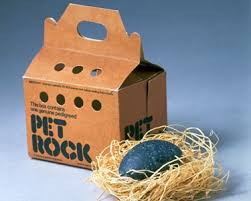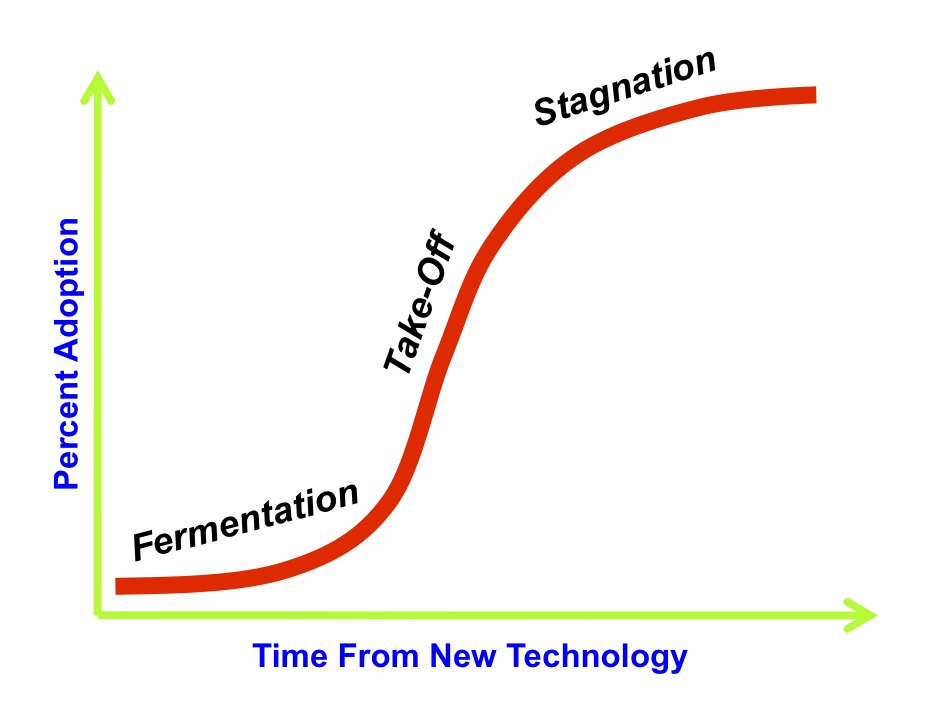Finding why things suck is important in a world of resource depletion. Our society has become accustomed to generating large amounts of waste and one of the sources is from products and services that no longer work properly. In the years ahead, we will no longer be able to absorb large amounts of wasted materials and effort. So, with that, let's look at one cause of why stuff sucks today. One cause can be due to the marketing cycle itself.
When it comes to the marketing cycle of products or services, most marketing text books show products tend to roughly follow an "S" curve similar to the one below.
The fermentation stage is where the first product or service gets test marketed and finally sold. Once it's clear the product or service can fulfill a legitimate demand, production goes up and there is usually an attempt to reduce costs. Some improvement attempts, such as buying component parts in larger quantities which can be produced and shipped with more efficient methods, will reduce unit cost without reducing the quality of the product. Some statistical based production methods, that can only be employed with large production quantities, may even improve the quality further. As the market gets saturated and competitors enter the market, the "stagnation" stage starts. At this point, the product or service is usually "value engineered" to increase profitability at the cost of quality. For example, durable metal parts may be replaced by weaker or less precise plastic parts to match the price of competitors.
The next reason things can suck, which is to my knowledge has never been mentioned in business textbooks, is cultural. At the stagnation stage, the corporation has been accustomed to high growth and fat margins. So to keep operating, it needs a way to either increase revenue or lower costs. Perhaps debt servicing requires high growth or maybe management is just used to paying themselves well. If those expenditures cannot be reduced, management naturally then looks to reducing other costs and there's usually no larger cost than employees. It is at this point that employees try to justify their existence in some way. This is where the product enters what I would call the "improve it till it sucks" phase. Rather than be satisfied with offering products that do their essential job well, employees propose new non-essential features, sales gimmicks and "improved" interfaces to promise sales levels and cost levels that will keep management happy.
The number of ideas people come up with to keep their jobs is truly amazing. This is especially true if salaried positions are decoupled with sales results. When this is the case, the "customer" often becomes upper management rather than people outside the company. Perhaps this is why websites often introduce "new and improved" features that cannot be accessed by anything except the latest web browsers or newest mobile devices (often operated by management). Other changes may lead to shorter product life which may force upgrades
or repeat sales in the short term. These changes, presented as "improvements", are what I would call the "keep your boss happy" product changes. They keep the boss happy but not the customer. This can be most easily seen in software where later versions either have feature encrustation or dumbed-down functionality in order to monetize a formerly free offering of features.
The customer can also be at fault too when it comes to demanding value from purchases. I suspect this is may be due to the cultural quest for seeking items that are "new" or "different" or it may just be due to declining per-capita wealth. Lack of demand for quality may also be due to the fracturing of traditional families which prevents high quality items from being passed down from generation to generation. This is not to say the demand for high quality items has vanished. Most people want items that perform well over many years. However, there is a significant risk to the customer for paying a premium for such items. It is all too tempting for a manufacturer to offer an item that appears higher quality, but really isn't. Perhaps all this is why, as my grandfather said, "You get what you pay for - only if you're lucky."
Ideas, news and just rants on how to address problems due to energy depletion and climate change.
Sunday, November 25, 2012
Monday, November 12, 2012
Improve it till it sucks, why it happens - part one
A long time ago in a career far-far away, I was once asked this question by my electronics store sales manager... He first told me, "Look around. Look at all the items in this store. Why are these particular items here?" I looked at the various items in the store. There were quite a variety with each having some utility but with almost no common use that I could see.
So, wondering where he was going with that question, I told him I had no idea. His reply was loud but direct, "THEY ARE HERE TO BE SOLD!". It was at that point when I finally truly understood the reasoning behind the apparent stupidity of some products. It now made sense why some of the higher priced radios sounded the same as the lower priced units with the only difference being that the higher priced unit had more functionally useless plastic parts stuck on them. It was the same reason some radios had excessive glowing lights, and LCD displays which looked high-tech but added virtually nothing to the music but were fetching higher prices than neighboring items on the shelf. I realized that the product designers simply wanted to maximize money. If it caused radios to become more ornate to sell better, so be it.
To multinational corporations, products are only useful as devices for which money is gathered. They have little sense of trying to make the world a better place. Rather, they are ultimately governed by stockholders and the legal requirement to make as high of a return for capital invested as possible. They care not if they sell round radios, yellow airplanes or square apples. As long as the items make money they are considered a success! In extreme cases, if an item is useful, it's almost a side effect. In many cases, the requirement of being useful isn't needed at all. Witness a fad from the 1970s called the pet rock.

The next piece of the puzzle, which I have never seen mentioned in any textbook, is another reason why so much stuff tends to improve till it sucks. When taken with this posting, it explains much.
See part two.
So, wondering where he was going with that question, I told him I had no idea. His reply was loud but direct, "THEY ARE HERE TO BE SOLD!". It was at that point when I finally truly understood the reasoning behind the apparent stupidity of some products. It now made sense why some of the higher priced radios sounded the same as the lower priced units with the only difference being that the higher priced unit had more functionally useless plastic parts stuck on them. It was the same reason some radios had excessive glowing lights, and LCD displays which looked high-tech but added virtually nothing to the music but were fetching higher prices than neighboring items on the shelf. I realized that the product designers simply wanted to maximize money. If it caused radios to become more ornate to sell better, so be it.
To multinational corporations, products are only useful as devices for which money is gathered. They have little sense of trying to make the world a better place. Rather, they are ultimately governed by stockholders and the legal requirement to make as high of a return for capital invested as possible. They care not if they sell round radios, yellow airplanes or square apples. As long as the items make money they are considered a success! In extreme cases, if an item is useful, it's almost a side effect. In many cases, the requirement of being useful isn't needed at all. Witness a fad from the 1970s called the pet rock.
The next piece of the puzzle, which I have never seen mentioned in any textbook, is another reason why so much stuff tends to improve till it sucks. When taken with this posting, it explains much.
See part two.
Subscribe to:
Posts (Atom)


